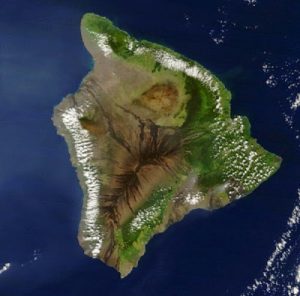
The footprints, made by warriors and their families, appear along a major trail in use at the time. Today, the area is one of the most visited parts of Hawai’i Volcanoes National Park.
The explosive eruption resulted from the violent interaction of groundwater with hot rocks. Such explosive eruptions have happened frequently in Kīlauea’s past and will probably occur in the future when the caldera collapses down to the water table, some 600 m (2000 ft) below the summit of the volcano.
The 1790 eruption of Kīlauea was explosive, and its major impacts were in the summit area of the volcano. The eruption taking place now at Kīlauea is effusive, says Swanson, producing a flow of lava that erupts without explosion. This flow is erupting from a site named Pu’u ‘Ō’ō on the east rift zone, far from the summit area, and lava has to flow many kilometers (several miles) before reaching inhabited areas.
Explosive eruptions are very hazardous; the 1790 fatalities bear witness to this fact. Lava flows are not very hazardous to life but can be exceedingly destructive to property. Explosive eruptions are brief but terrifying. Lava flows often last for months or more and are captivating to the viewer. Kīlauea has both types of eruptions, but not at the same time.
Violent explosive eruptions from the summit of Kīlauea are geologically common. They are generally clustered into periods lasting a few centuries. It has been about 200 years since the most recent major explosion, which culminated about 300 years of frequent explosive eruptions. In the past 200 years, Kīlauea has produced many lava flows similar to the present one; small explosions took place in 1924 and, on an even smaller scale, during the past 6 years.
The general public is unaware of Kīlauea’s explosive nature, because the volcano has erupted mainly lava flows in recent times. Kīlauea will almost certainly become explosive at some future time, producing conditions similar to those of 1790. However, according to Swanson, there is no reason to think that a period of violent eruptions will resume any time soon. The public can probably expect more lava flows in the near future, such as those of the past three decades from Pu’u ‘Ō’ō.
Reference:
D. A. Swanson, S. J. Weaver, B. F. Houghton. Reconstructing the deadly eruptive events of 1790 CE at K lauea Volcano, Hawai’i. Geological Society of America Bulletin, 2014; DOI: 10.1130/B31116.1
Note : The above story is based on materials provided by Geological Society of America.










